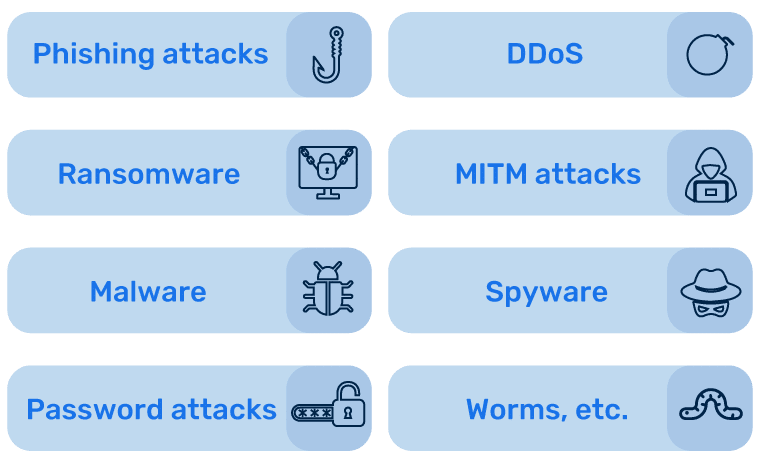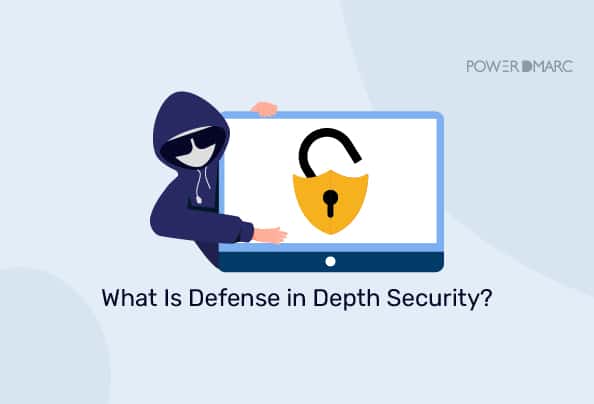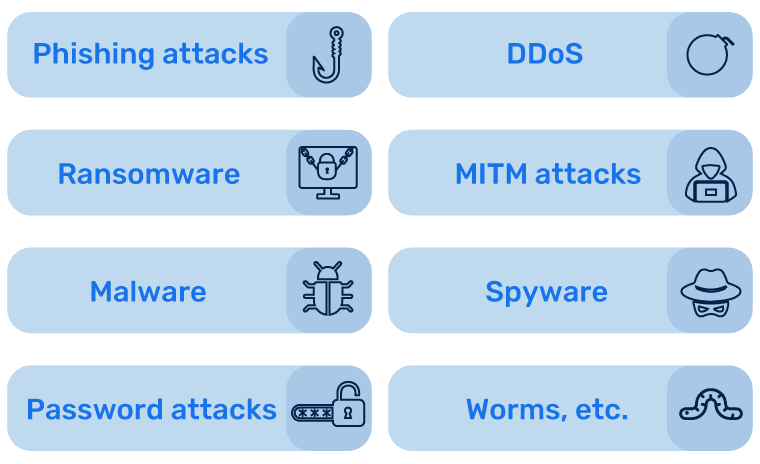
Reading Time: 5 min

If you or your company has ever experienced a cyberattack, you may have encountered significant loss and reconsidered the value of cybersecurity. When it comes to digital agencies, SaaS and IT companies, and even independent freelancers—anyone who deals with a lot of technology in the workplace should be aware of potential threats waiting for them on the web.
The rising number of cybercrimes (and total losses caused by them), as well as changing work environments, force companies and independent specialists to prioritize their security in 2024. The concept of defense in depth security might be the missing link to ensuring your safety. This guide will explain this concept to you and help you understand how it can potentially help you mitigate cybersecurity risks.
What Is Defense in Depth?
Defense in depth is a holistic security strategy that implies leveraging multiple layers of protection to secure an organization or individual and their assets. The core idea behind this concept is simple: if one line of your security is broken, the following layers act as a backup. This approach enables you to stop potential threats by compensating for possible vulnerabilities.
Does it only work in the digital medium? While defense in depth is widely used to address software and hardware security, it also deals with people. Your defense system might include layers that protect you from security breaches initiated by human error or negligence.
Core Elements of Defense in Depth
Defense in depth can span many different layers, approaches, and tools to create the most secure user environment. Yet, most of its elements can be divided into five key categories that are integral to defense-in-depth security systems:

- Physical controls—The first line of defense includes security measures that control physical access to a company’s building, IT systems, and other assets. Some examples of physical controls include locked doors, security guards, entrance keys and cards, fingerprint scanners, etc.
- Network security controls—Another layer of protection includes security measures that protect unauthorized access to your networks and continuously analyze network traffic to identify unsafe traffic and block it. Simply put, these controls enable only users or employees to use specific devices, applications, software, and so on through authentication and authorization. Common types of network security controls include firewalls, intrusion protection systems, etc.
- Administrative controls—While network security controls authorize users’ general access to networks, administrative controls allow access to certain types of applications, data, or parts of the network to authenticated employees. For example, these controls can include policies and procedures that regulate employees’ access to certain assets based on their roles or levels of access.
- Antivirus software—Antivirus software holds a special place in effective defense in depth security. These tools add an extra layer of protection to your personal or corporate gadgets, systems, and networks to prevent malicious software from entering and spreading.
- Behavioral analysis algorithms—Finally, the last line of defense includes behavioral analysis systems. These systems are used to collect and analyze data about the behavior of users, applications, and devices. This analysis can help identify suspicious or abnormal behavioral patterns and block them to prevent security breaches.
Changing Work Environments and Digital Threats That Stimulate the Rise of Defense in Depth
As you already know, defense in depth creates multiple lines of protection to secure you or your company from a variety of potential issues.
But why is there a need to create such complex security systems?
There are two primary reasons that answer this question. The first incentive is a changing work environment. In recent years, we’ve observed a growing trend for remote or partially remote employment formats. With more employees working from home (and, respectively, accessing their companies’ assets from their own devices), organizations have to strengthen their security measures. This is important to mitigate potential breaches caused by employees’ unprotected Wi-Fi connections or devices.
In addition to the changing work environments in companies, we can also observe changes in the work of self-employed specialists. More and more specialists in the arts, IT, education, and many other industries now choose to be self-employed and work as freelancers. As freelancers, they often have to handle sensitive customer data, including personal information, financial details, confidential business information, and so on. They also have to rely on technology a lot in these sensitive situations, making them vulnerable to risks. So, if you are an essay writer online working for an academic paper writing service, a software engineer, or another self-employed specialist, you may also be facing the need to implement defense in depth to prevent breaches.
The second factor is the growing number of potential hazards existing on the Internet today. The FBI’s Internet Crime Complaint Center (IC3) reported over 800k cybercrime complaints with a total loss of over $10 billion in 2022, shattering 2021’s numbers with a total loss of $6.9 billion. Given the rise in potential risks and losses, the importance of holistic security rises as well.
How Does Defense in Depth Change the Situation?
The number of threats is constantly growing. They come in many different types, including:

- Phishing attacks
- Ransomware
- Malware
- Password attacks
- DDoS
- MITM attacks
- Spyware
- Worms, etc.
Each of these threats can lead to significant losses for you or your company. To complicate matters, every type of threat has a different nature and unique specs. That is, addressing each may require different security measures.
Defense in depth can duplicate and layer your security processes. By doing this, it enables your organization to address different types of threats at once and minimize the likelihood of a breach.
For example, if you only use one line of defense, let’s say physical controls, it will protect you from physical unauthorized access to your assets. However, it will not protect you from malicious software or cyber attacks.
On the other hand, if you implement defense in depth, you increase the sophistication of your security system and shield yourself or your company from a broader range of risks.
The Bottom Line
Defense in depth is an all-rounded approach to security that creates a multi-layer shield to protect you and your company from potential hazards. These days, due to changing work environments, increasing reliance on technology, and growing numbers of threats, this kind of holistic protection is a must not only for large companies but also for startups and self-employed freelancers.

*** This is a Security Bloggers Network syndicated blog from PowerDMARC authored by Ahona Rudra. Read the original post at: https://powerdmarc.com/layered-defence-in-depth-security/
如有侵权请联系:admin#unsafe.sh